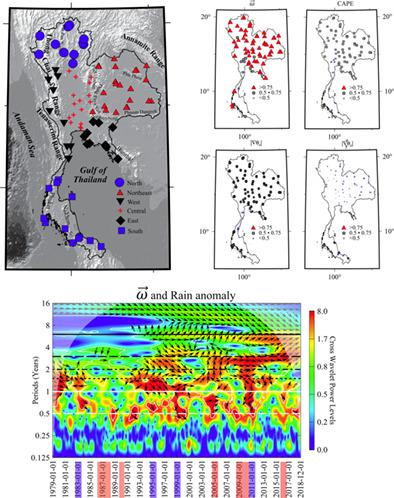当前位置:
X-MOL 学术
›
Int. J. Climatol.
›
论文详情
Our official English website, www.x-mol.net, welcomes your feedback! (Note: you will need to create a separate account there.)
Influence and variability of monsoon trough and front on rainfall in Thailand
International Journal of Climatology ( IF 3.9 ) Pub Date : 2021-06-20 , DOI: 10.1002/joc.7263 Saifhon Tomkratoke 1 , Sirod Sirisup 1
International Journal of Climatology ( IF 3.9 ) Pub Date : 2021-06-20 , DOI: 10.1002/joc.7263 Saifhon Tomkratoke 1 , Sirod Sirisup 1
Affiliation

|
High variabilities in rainfall and the subsequent consequences have caused severe water-related issues for Thailand over recent decades. In this study, the factors that affect rainfall variability over Thailand were determined. The spatio-temporal structures of the monthly rainfall in Thailand between 1979 and 2018 were extracted via an empirical orthogonal function (EOF) analysis. With a unimodal temporal structure, the first EOF mode suggests the overall phenomenon governing rain characteristics in Thailand. The higher modes, consisting of bimodal temporal structures, indicate different rain phenomena in various regions. A significantly high correlation between the 3-month average of the monsoon trough index and rainfall was observed, while wet adiabatic front and convective available potential energy (CAPE) data had a moderately high correlation. Only the local front index, within the Gulf of Thailand, correlated to the rain characteristics along the east coast of southern Thailand. The cross-wavelet analysis indicated that most of the rainfall variability correlates with monsoon trough. However, the front can involve extreme events. The interannual variability of monsoon trough and rainfall with a dominant time scale between 3.0 and 6.0 years has significantly increased since 1995. Meanwhile, the intra-annual variability is more intermittent, indicating rare intensified strong tropical cyclones along the monsoon troughs in Thailand. The interannual variability of the monsoon trough and front indices also intermittently connects with the Southern Oscillation Index (SOI). However, the relationship in annual and intra-annual cycles is mostly weak. Therefore, the dependence of interannual variability of rainfall in Thailand on SOI or monsoon trough is comparable. Notably, the intra-annual rainfall variability is heavily influenced by the monsoon trough and front. This study is the first to identify the crucial factors behind the seasonal rain phenomena in Thailand. This information will benefit seasonal rainfall predictors and increase preparedness for hydro-climatic related disasters in the Indo-China region.
中文翻译:

季风槽和锋面对泰国降雨的影响和变化
近几十年来,降雨量的高度变化以及随之而来的后果给泰国造成了严重的与水有关的问题。在这项研究中,确定了影响泰国降雨变化的因素。通过经验正交函数 (EOF) 分析提取了 1979 年至 2018 年间泰国月降雨量的时空结构。第一个 EOF 模式具有单峰时间结构,表明了泰国降雨特征的总体现象。由双峰时间结构组成的较高模式表明不同地区的不同降雨现象。观察到季风槽指数的 3 个月平均值与降雨量之间存在显着的高相关性,而湿绝热锋和对流可用势能(CAPE)数据具有中高相关性。只有泰国湾内的局部锋面指数与泰国南部东海岸的降雨特征相关。交叉小波分析表明,大部分降雨变化与季风槽相关。但是,前线可能涉及极端事件。自 1995 年以来,以 3.0 年至 6.0 年为主导时间尺度的季风槽和降雨的年际变率显着增加。同时,年内变率更具间歇性,表明泰国季风槽沿线罕见的强热带气旋增强。季风槽和锋面指数的年际变率也间歇性地与南方涛动指数(SOI)相关。然而,年周期和年内周期的关系大多较弱。因此,泰国降雨量的年际变率对 SOI 或季风槽的依赖性具有可比性。值得注意的是,年内降雨变率受季风槽和锋面的影响很大。这项研究首次确定了泰国季节性降雨现象背后的关键因素。这些信息将有利于季节性降雨预报,并加强对印度支那地区水文气候相关灾害的准备。这项研究首次确定了泰国季节性降雨现象背后的关键因素。这些信息将有利于季节性降雨预报,并加强对印度支那地区水文气候相关灾害的准备。这项研究首次确定了泰国季节性降雨现象背后的关键因素。这些信息将有利于季节性降雨预报,并加强对印度支那地区水文气候相关灾害的准备。
更新日期:2021-06-20
中文翻译:

季风槽和锋面对泰国降雨的影响和变化
近几十年来,降雨量的高度变化以及随之而来的后果给泰国造成了严重的与水有关的问题。在这项研究中,确定了影响泰国降雨变化的因素。通过经验正交函数 (EOF) 分析提取了 1979 年至 2018 年间泰国月降雨量的时空结构。第一个 EOF 模式具有单峰时间结构,表明了泰国降雨特征的总体现象。由双峰时间结构组成的较高模式表明不同地区的不同降雨现象。观察到季风槽指数的 3 个月平均值与降雨量之间存在显着的高相关性,而湿绝热锋和对流可用势能(CAPE)数据具有中高相关性。只有泰国湾内的局部锋面指数与泰国南部东海岸的降雨特征相关。交叉小波分析表明,大部分降雨变化与季风槽相关。但是,前线可能涉及极端事件。自 1995 年以来,以 3.0 年至 6.0 年为主导时间尺度的季风槽和降雨的年际变率显着增加。同时,年内变率更具间歇性,表明泰国季风槽沿线罕见的强热带气旋增强。季风槽和锋面指数的年际变率也间歇性地与南方涛动指数(SOI)相关。然而,年周期和年内周期的关系大多较弱。因此,泰国降雨量的年际变率对 SOI 或季风槽的依赖性具有可比性。值得注意的是,年内降雨变率受季风槽和锋面的影响很大。这项研究首次确定了泰国季节性降雨现象背后的关键因素。这些信息将有利于季节性降雨预报,并加强对印度支那地区水文气候相关灾害的准备。这项研究首次确定了泰国季节性降雨现象背后的关键因素。这些信息将有利于季节性降雨预报,并加强对印度支那地区水文气候相关灾害的准备。这项研究首次确定了泰国季节性降雨现象背后的关键因素。这些信息将有利于季节性降雨预报,并加强对印度支那地区水文气候相关灾害的准备。

























 京公网安备 11010802027423号
京公网安备 11010802027423号